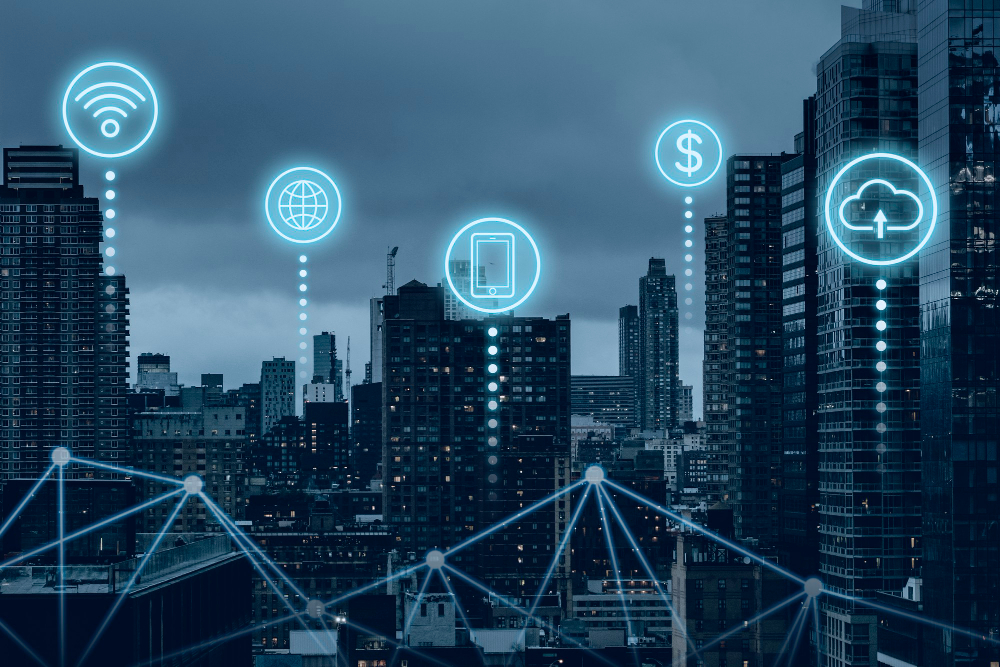— DOWN Stream
Fueling Tomorrow
IoT Precision Unleashing Efficiency, Safety, and Customer Delight in Downstream Energy.
The downstream oil and gas industry encompasses the intricate processes involved in refining crude oil and natural gas, culminating in the distribution and marketing of vital end-products, including gasoline, diesel, jet fuel, lubricants, and petrochemicals¹. Embracing the transformative power of IoT devices holds the key to enhancing operational excellence, ensuring safety, and elevating customer satisfaction within this dynamic sector. By seamlessly integrating real-time monitoring, advanced data analysis, and intelligent automation, IoT devices empower the downstream industry to revolutionize processes and optimize assets, thereby ushering in a new era of efficiency and reliability. This technological synergy not only ensures that operations run with precision but also fosters a proactive approach to maintenance, reducing downtime and contributing to sustainable and secure practices in the oil and gas landscape. In essence, IoT devices emerge as catalysts for progress, reshaping the downstream oil and gas industry into a realm of heightened efficiency, safety, and unparalleled customer contentment.
FEATURES
IoT Empowers Downstream Dynamics: Redefining Precision, Safety, and Customer Delight in Oil & Gas Excellence.
— 01
Remote Monitoring And Control
IoT devices have the capability to gather and transmit data from pipelines, storage tanks, refineries, and distribution networks, enabling operators to centrally monitor and control operations. This centralized oversight not only lowers operational costs and enhances overall performance but also serves as a preventive measure against potential leaks or accidents.
— 02
Predictive Maintenance
IoT devices have the capability to monitor the condition and performance of equipment and machinery, providing timely alerts to operators regarding potential failures or malfunctions. This proactive monitoring enables the scheduling of preventive maintenance, resulting in reduced downtime and an extension of the lifespan of critical assets.
— 03
Process Optimization
IoT devices are equipped to measure and analyze diverse parameters, including pressure, temperature, flow rates, and product quality. They offer valuable feedback to optimize production processes, leading to heightened efficiency, waste reduction, and increased output.
— 04
Safety And Security
IoT devices have the capability to identify and report hazardous situations, such as gas leaks, fires, or intrusions. In response, they can activate appropriate measures, such as alarms, notifications, or emergency shutdowns. This proactive approach serves to safeguard workers, the environment, and assets from potential harm.
— 05
Supply Chain Management
IoT devices are capable of tracking and monitoring the movement and location of products throughout the supply chain, starting from the refinery to the end-user. This capability enhances visibility, traceability, and inventory management, ensuring timely and accurate deliveries.
— 06
Customer Engagement
IoT devices offer customers information and services, including details on product availability, pricing, loyalty programs, and feedback. This functionality serves to elevate customer satisfaction, retention, and loyalty.
PROFILE
Breathing smart, living clean – navigating a Greener future!
Cloud Native
Pre-built Connectors
Visual Workflow Editor
Unified data and Analytics Engine
Customizable Dashboards
Scalable, flexible, and secure

UNIQUENESS
Unleashing Downstream Excellence: Efficiency, Safety, Innovation, and Customer-Centric Evolution.
Fueling the future
This proposition underscores the pivotal role of IoT in propelling the downstream sector to unparalleled levels of efficiency, safety, and customer satisfaction. By seamlessly integrating real-time monitoring, advanced data analysis, and intelligent automation, IoT becomes the catalyst for optimizing diverse processes and assets within the industry.
Streamlining with smart solutions
This proposition accentuates the transformative impact of IoT on the downstream sector, offering a pathway to significant reductions in operational costs, performance enhancements, and proactive prevention of leaks or accidents. Through the implementation of remote monitoring and control, predictive maintenance, and process optimization, IoT emerges as a powerful solution driving operational efficiency and safety within the industry.
Enhancing data-driven insights
This proposition highlights the dynamic role of IoT in empowering the downstream sector to amplify output, minimize waste, and elevate product quality. By facilitating seamless data collection and analysis, coupled with system-wide real-time production control and feedback loops, IoT emerges as the catalyst for optimizing processes and driving continuous improvement throughout the industry.
Transforming innovative applications
This proposition illustrates the transformative influence of IoT in empowering the downstream sector to forge innovative value propositions, business models, and enriching customer experiences. By facilitating comprehensive supply chain management, environmental monitoring, and proactive customer engagement, IoT emerges as the driving force behind the industry’s evolution towards novel and customer-centric approaches.
BENEFITS
Navigating Challenges, Pioneering Solutions: IoT Empowering Downstream Excellence for Efficiency, Safety, and Sustainability.
The downstream oil and gas sector encounters diverse challenges, including operational inefficiency, safety and security concerns, customer dissatisfaction, and environmental impacts. Addressing these challenges is possible through the deployment of IoT devices, facilitating real-time monitoring, data analysis, automation, and optimization across processes and assets. Moreover, IoT devices enhance customer experience and loyalty by providing valuable information and services. Embracing IoT solutions positions the downstream oil and gas industry to attain elevated levels of efficiency, safety, and sustainability.

Improved operational efficiency
IoT devices contribute to the streamlining of oil and gas product processing and distribution, resulting in reduced operational costs and improved product quality. This is achieved through the facilitation of real-time monitoring, data analysis, automation, and optimization across various processes and assets.

Increased safety and security
Leveraging IoT devices aids in the identification and prevention of hazardous situations, such as gas leaks, fires, or intrusions. In response, these devices can activate suitable measures, including alarms, notifications, or emergency shutdowns, safeguarding workers, the environment, and valuable assets from potential harm.

Enhanced customer satisfaction
IoT devices play a crucial role in delivering customers information and services, including details on product availability, pricing, loyalty programs, and feedback. This capability enhances customer retention, loyalty, and overall satisfaction.

Reduced environmental impact
Utilizing IoT devices enables the monitoring and mitigation of the carbon footprint and greenhouse gas emissions associated with downstream operations, ensuring adherence to environmental regulations and standards.
Fueling Tomorrow's Downstream Excellence with IoT Precision Unleashes Efficiency, Safety, and Customer Delight
Our transformative technologies redefine efficiency, safety, and customer satisfaction, ushering in a sustainable and technologically advanced era for the entire downstream sector.
COPYRIGHT © RAY GROUP HOLDINGS. ALL RIGHTS RESERVED.
